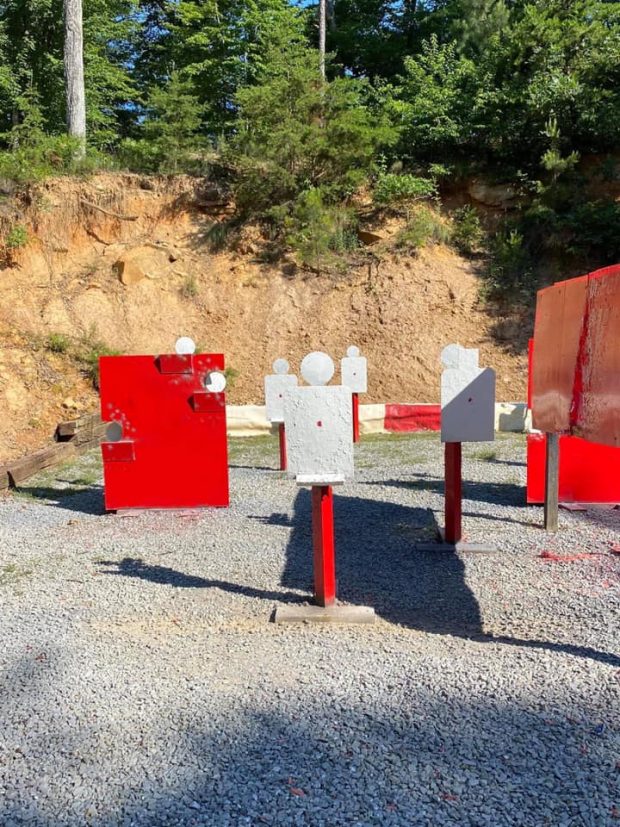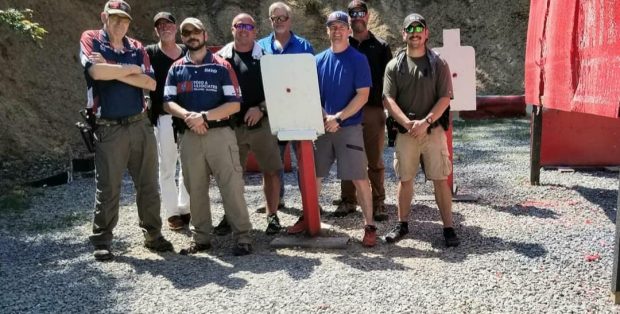Written by Greg Ellifritz
My shooting skills have been slipping.
I retired from my police job last August. Since I’m not confronting criminals on a daily basis, the motivation to stay in tip top form is diminished. Combine that with Covid-related range closings, high ammo prices, and the fact that I’ve nearly spent more time outside the USA than at home this year, and the result is a guy who hasn’t practiced his shooting skills as much as he should.
In this calendar year, I moved to Mexico for more than a month and stayed multiple weeks in Brazil, The Dominican Republic, and Costa Rica. Not only is it impossible to shoot in those locations, I can’t even dry fire. My normal shooting 500-1000 rounds a month was reduced to less than 1000 rounds total fired in 2021. I’m not as good as I was a year or more ago.
No excuses. I just haven’t been doing the work.
When Shelley and Brian Hill from The Complete Combatant reached out to me with the opportunity to book a class on a Rogers Range with former Rogers lead instructor Ronnie Dodd, I jumped on the chance. I badly needed a tune up and that’s exactly what I got.

Last week, I took Ronnie Dodd’s three day reactive shooting class. Read Ronnie’s biography as well as his list of instructor certifications. As general guidance, if you are ever considering taking a firearms class from absolutely anyone, check out their biography and lists of training that they have completed as a student. If a website doesn’t have that info in today’s world, your instructor may not be worthy of the class tuition you are about to spend.
Look for an instructor candidate who has certifications from more than one organization. Look for an instructor who has taken lots of classes across a broad domain of personal defense subjects. Look for actual teaching experience. Ronnie Dodd passed those tests. Even though I had never met Ronnie before the class, after looking at his bio I was satisfied he would teach a good class. I was not disappointed.
Bill Rogers designed a pneumatic pop-up steel target range to best train shooters in “reactive” shooting. Targets are exposed for a very short period of time, forcing students to shoot faster than any other program. One can’t pass the class using traditional shooting methods of perfect sight alignment and a surprise trigger break. When targets appear for only 1/2 second, the shooter is forced to drive the gun to the target, obtain an acceptable sight picture, and press the trigger quickly before it disappears. The system forces the students to shoot faster than they ever have shot before.
The range consists of seven pop up targets that are eight inches in diameter. The targets are placed between seven and twenty yards away from the shooter. The Rogers system is based around a test consisting of nine timed stages and 125 possible hits on these head shot sized targets. Forty percent of the shots are fired strong or weak handed only.
At the end of each day of training, we shot the 125 round test. It was rough. Ronnie told us that he regularly saw police officers and full time SWAT cops only hitting 30-40 of the 125 possible targets.
Under the Rogers system, hitting 70 of 125 gives you a “basic” or “passing” rating. Hitting over 90 targets gets an “intermediate” rating. Over 110 gets “advanced.” Only about five percent of students hit the “advanced” score and only six people total have shot a perfect 125 in the multiple-decade history of the competition.

A bay at the Rogers Range. Nine targets (all head shots) placed between seven and 20 yards away from the shooter.
The Rogers Range is no joke.
The seven other students were serious shooters. Six of the eight students were hand recruited by Brian and Shelley Hill for this particular class. The two remaining students were multiple graduates of both the original Rogers program in Georgia and Ronnie’s program in Tennessee. It was an absolute delight to spend three days shooting with such a highly skilled bunch.
As soon as we all started shooting, Ronnie began commenting on the high skill level in the class. I thought I was shooting really poorly. Apparently not. On the test at the end of the first day all of us scored at least “basic” ratings. We were the first class at Dodd’s range who ever achieved that accomplishment.
It was a bit of an ego hit for me. I’m used to performing at the top end of any shooting class I attend. I was high shooter in two of the 50+ student classes I took with Rob Leatham. I won two of the three class shoot offs at a Steve Fischer carbine class a couple years ago. I’ve earned my share of top shooter challenge coins at the various Rangemaster instructor classes I’ve attended in the last couple years. I may not be the top shooter in every class I take, but I can’t remember the last time I was outside the top 10%.
This isn’t bragging. I’m not the world’s best shooter, but I’m pretty solid. That’s why it absolutely shocked me to find out that my shooting scores ranked me number seven out of eight students after the first test. That was an absolute ego check.
I knew classmates Rick Remington and Brian Hill going into the class. Both are phenomenal shooters who have beaten me in competitions before. I expected them to perform well. I didn’t know the other two guys recruited by the Hills, but Brandon Powers (who took the top shooter award) and Erik Chesney were master class shooters as well. The two other students were multiple Rogers graduates and far more capable than most folks I see in class. Everyone was shooting well and I scored near the bottom of the pack.

Class photo
I had to put my ego in check. I knew I wasn’t at the top of my game. I was taking the class to improve my skill levels. I had to let go of some of my ego-driven competitive personality traits in order to optimize my learning.
I honestly wouldn’t have been as motivated to better my performance if I had been the class top shooter on day one. Being near the bottom of the pack forced me to work harder and pay more attention. I didn’t want to be the guy at the absolute bottom of the score sheet. Avoiding that motivated me to work harder than in most of the classes I have taken. The lessons learned from sucking in comparison to one’s peers alone was worth the price of the course and the ammunition.
I shut up and paid attention. Both the class instructors (Ronnie Dodd and David Smith) were excellent coaches. I got even more informal coaching from the other members of the class. Everyone there was tremendously positive and helpful. The group was dedicated to making everyone better. I ended up learning a quite a bit just by watching superior shooters and talking to them about ways I could improve my personal performance. I ended up in the perfect storm of set, setting, and characters that greatly improved my ability to both shoot and to coach other shooters. It was money well spent.
Here are a couple of short videos to show you how this range works. The first one is a practice drill where we fired six body shots and one head shot at seven yards in under two seconds from the low ready position..
The next is one of the weak hand only stages. Six shots weak handed, a weak hand only reload, and three more targets on the “wall.” You’ll notice I miss a few here. This was my worst stage. According to Ronnie, he regularly sees students in his class who fail to knock down a single plate on this exercise.
I was shooting my Gen 5 Glock 19 from a Safariland ALS holster. The gun is bone stock except for the addition of Ameriglo sights. Every other shooter in the class used a red dot optic during at least some portion of the class. Some of my classmates’ guns were a bit tricked out with lighter triggers, red dot optics, and compensators. I shot the gun I carry concealed every day. That put me at a bit of a disadvantage as compared to the other shooters, but my job was to improve my own shooting, not to win the class shooting competition. I’m OK with handicapping myself by shooting my primary carry gun.
We shot the test four times in three days. My scores were 84, 89, 91, and 90. I just barely squeezed into the “intermediate” category with my last two runs. Rick, Brandon, and Erik got the coveted “advanced” rating. The rest of the class also scored “intermediate.” My cumulative totals placed me in sixth place out of eight shooters. According to Ronnie, this was his first class ever to have all students shoot to “intermediate” level or higher.
The class highlighted my deficiencies. If I want the “advanced” ticket, I’m going to have to do a lot more single-hand shooting. I lost the majority of my points in the support hand only drills. I think with enough work on my off handed shooting, I may be able to break into “advanced” by next year. I’m going to give it a try. While this is probably not the class to attend to learn how to shoot, it is a great class to improve your abilities and show you where you need to exert more effort in your practice sessions.
I’m considering running this course every year or two as a diagnostic skill builder.
Thank you to Shelley and Brian Hill from The Complete Combatant for organizing the trip. If you get a chance, take one of Brian’s classes. He’s one of the best instructors in the industry. Better yet, host him for a class!
Finally, if you get a chance to take a class from Dodd and Associates Training on the Rogers target system, you should. I can see this one being a regular “tuneup” class for me to do every year or two.

